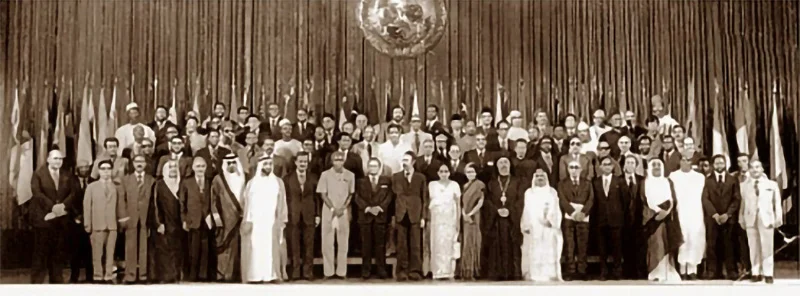Features
Revisiting Non-Alignment and Multi-Alignment in Sri Lanka’s foreign policy


Sabry outlines five key pillars of a non-aligned yet multi-aligned foreign policy:
- No military alignments, no foreign bases: Sri Lanka should avoid entangling itself in military alliances or hosting foreign military bases.
- Economic engagement with all, dependency on none
: Sri Lanka should diversify its economic partnerships to avoid over-reliance on any single country.
* Diplomatic balancing
: Sri Lanka should engage with multiple powers, leveraging relationships with China, India, the US, Europe, Japan, and ASEAN for specific benefits.
- Leveraging multilateralism
: Sri Lanka should participate actively in regional and global organisations, such as UN, NAM, SAARC, and BIMSTEC.
- Resisting coercion and protecting sovereignty
: Sri Lanka must resist external pressures and assert its sovereign right to pursue an independent foreign policy.
While pillars 1, 2, and 5 align with the traditional principles of non-alignment, pillars 3 and 4 warrant closer scrutiny. Sabry’s emphasis on “diplomatic balancing” and “leveraging multilateralism” raises questions about the consistency of his approach with the spirit of non-alignment and whether it adequately addresses the challenges of a multipolar world.
Dangers of over-compartmentalisation
Sabry’s suggestion that Sri Lanka should engage with China for infrastructure, India for regional security and trade, the US and Europe for technology and education, and Japan and ASEAN for economic opportunities reflects a pragmatic approach to foreign policy. However, this compartmentalisation of partnerships risks reducing Sri Lanka’s foreign policy to a transactional exercise, undermining the principles of non-alignment.
Sabry’s framework, curiously, excludes China from areas like technology, education, and regional security, despite China’s growing capabilities in these domains. For instance, China is a global leader in renewable energy, artificial intelligence, and 5G technology, making it a natural partner for Sri Lanka’s technological advancement. Similarly, China’s Belt and Road Initiative (BRI) offers significant opportunities for economic development and regional connectivity. By limiting China’s role to infrastructure, Sabry’s approach risks underutilising a key strategic partner.
Moreover, Sabry’s emphasis on India for regional security overlooks the broader geopolitical context. While India is undoubtedly a critical partner for Sri Lanka, regional security cannot be addressed in isolation from China’s role in South Asia. The Chinese autonomous region of Xizang (Tibet) is indeed part of South Asia, and China’s presence in the region is a reality that Sri Lanka must navigate. A truly non-aligned foreign policy would seek to balance relationships with both India and China, rather than assigning fixed roles to each.
Sabry’s compartmentalisation of partnerships risks creating silos in Sri Lanka’s foreign policy, limiting its flexibility and strategic depth. For instance, by relying solely on the US and Europe for technology and education, Sri Lanka may miss out on opportunities for South-South cooperation with members of BRICS.
Similarly, by excluding China from regional security discussions, Sri Lanka may inadvertently align itself with India’s strategic interests, undermining its commitment to non-alignment.
Limited multilateralism?
Sabry’s call for Sri Lanka to remain active in organisations like the UN, NAM, SAARC, and BIMSTEC is laudable. However, his omission of the BRI, BRICS, and the Shanghai Cooperation Organisation (SCO) is striking. These platforms represent emerging alternatives to the Western-dominated global order and offer Sri Lanka opportunities to diversify its partnerships and enhance its strategic autonomy.
The BRI is one of the most ambitious infrastructure and economic development projects in history, involving over 140 countries. For Sri Lanka, the BRI offers opportunities for infrastructure development, trade connectivity, and economic growth. By participating in the BRI, Sri Lanka can induce Chinese investment to address its infrastructure deficit and integrate into global supply chains. Excluding the BRI from Sri Lanka’s foreign policy framework would be a missed opportunity.
BRICS and the SCO represent platforms for South-South cooperation and multipolarity. BRICS, in particular, has emerged as a counterweight to such Western-dominated institutions as the IMF and World Bank, advocating for a more equitable global economic order. The SCO, on the other hand, focuses on regional security and counterterrorism, offering Sri Lanka a platform to address its security concerns in collaboration with major powers like China, Russia, and India. By engaging with these organisations, Sri Lanka can strengthen its commitment to multipolarity and enhance its strategic autonomy.
Non-alignment is not neutrality
Sabry’s assertion that Sri Lanka must avoid taking sides in major power conflicts reflects a misunderstanding of non-alignment. Non-alignment is not about neutrality; it is about taking a principled stand on issues of global importance. During the Cold War, non-aligned countries, like Sri Lanka, opposed colonialism, apartheid, and imperialism, even as they avoided alignment with either the US or the Soviet Union.
Sri Lanka’s foreign policy, under leaders like S.W.R.D. Bandaranaike and Sirimavo Bandaranaike, was characterised by a commitment to anti-colonialism and anti-imperialism, opposing racial segregation and discrimination in both its Apartheid and Zionist forms. Sri Lanka, the first Asian country to recognise revolutionary Cuba, recognised the Palestine Liberation Organisation (PLO) and the Provisional Revolutionary Government of South Vietnam, supported liberation struggles in Africa, and opposed the US military base in Diego Garcia. These actions were not neutral; they were rooted in a principled commitment to justice and equality.
Today, Sri Lanka faces new challenges, including great power competition, economic coercion, and climate change. A truly non-aligned foreign policy would require Sri Lanka to take a stand on issues like the genocide in Gaza, the colonisation of the West Bank, the continued denial of the right to return of ethnically-cleansed Palestinians and Chagossians, the militarisation of the Indo-Pacific, the use of economic sanctions as a tool of coercion, and the need for climate justice. By avoiding these issues, Sri Lanka risks becoming the imperialist powers’ cringing, whingeing client state.
The path forward
Sabry’s use of the term “multi-alignment” reflects a growing trend in Indian foreign policy, particularly under the BJP Government. However, multi-alignment is not the same as multipolarity. Multi-alignment implies a transactional approach to foreign policy, where a country seeks to extract maximum benefits from multiple partners without a coherent strategic vision. Multipolarity, on the other hand, envisions a world order where power is distributed among multiple centres, reducing the dominance of any single power.
Sri Lanka should advocate for a multipolar world order that reflects the diversity of the global South. This would involve strengthening platforms like BRICS, the SCO, and the NAM, while also engaging with Western institutions like the UN and the WTO. By promoting multipolarity, Sri Lanka can contribute to a more equitable and just global order, in line with the principles of non-alignment.
Ali Sabry’s call for a non-aligned, yet multi-aligned foreign policy falls short of articulating a coherent vision for Sri Lanka’s role in a multipolar world. To truly uphold the principles of non-alignment, Sri Lanka must:
* Reject compartmentalisation
: Engage with all partners across all domains, including technology, education, and regional security.
* Embrace emerging platforms
: Participate in the BRI, BRICS, and SCO to diversify partnerships and enhance strategic autonomy.
* Take principled stands
: Advocate for justice, equality, and multipolarity in global affairs.
* Promote South-South cooperation
: Strengthen ties with other Global South countries to address shared challenges, like climate change and economic inequality.
By adopting this approach, Sri Lanka can reclaim its historical legacy as a leader of the non-aligned movement and chart a course toward a sovereign, secure, and successful future.
(Vinod Moonesinghe read mechanical engineering at the University of Westminster, and worked in Sri Lanka in the tea machinery and motor spares industries, as well as the railways. He later turned to journalism and writing history. He served as chair of the Board of Governors of the Ceylon German Technical Training Institute. He is a convenor of the Asia Progress Forum, which can be contacted at asiaprogressforum@gmail.com.)
by Vinod Moonesinghe